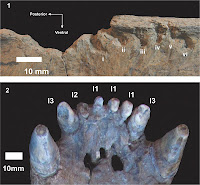Pristinailurus
bristoli is a Late Miocene Ailurid Mammal (a group that includes
the modern Red Panda as its only living relative) from the Gray
Fossil Site in northeast Tennessee. It was first described in 2004
from a mature individual estimated to have weighed about 8.25 kg in
life. In 2011 a second specimen was described from the same site.
This second specimen was much larger than the original, reconstructed
as having weighed about 15 kg, but the individual appeared to be
younger than the original specimen, which had very badly worn down
teeth, usually accepted as a sign of age. This raises the possibility
that the species may have been sexually dimorphic (i.e. adults of the
two sexes may have been different sizes), though this is difficult to
assert from only two specimens, and does not fit with the biology of
the living Red Panda, in which both sexes tend to be the same size.
In a paper published in
the journal Palaeontologica Electronica in September 2015, Ethan Fulwood
of the Department of Anthropology at the University of Tennessee, Knoxville and
the Department of Evolutionary Anthropology at Duke University and Steven Wallace of the Department of Geosciences and Don Sundquist Center of Excellence in Paleontology at East Tennessee State University publish
a morphometric analysis of the skeletons of modern Red Pandas,
Ailurus fulgens, which they believe supports the presence of sexual
dimorphism within the Ailurid group as a whole.
Size differences
between Ailurus fulgens (1) and the two known skeletons of
Pristinailurus bristoli (2) and (3). Shaded bones represent
recovered elements from the two fossil skeletons. Fulwood &
Wallace (2015).
Modern Red Pandas have an
unusual reproductive strategy for Carnivorans, being non-competative
and promiscuous, with conflict between males being extremely rare.
This gives no reason for males to be larger than females (or vice
versa) and the two sexes are roughly the same size. However sexual
dimorphism tends to be a conserved trait within Carnivorans, existing
or not across whole groups of species regardless of the mating
behaviour of individual species. Therefore it would be expected that
if mate-competition and sexual dimorphism were historically found
within the Ailurids then traces of it would be likely to be retained
in modern Red Pandas, even if this no longer conferred any ecological
advantage.
Fulwood and Wallace took
23 measurements of the bones and teeth of 22 Red Panda specimens in
museum collections (11 males and 11 females). In almost all of these
measurements the two sexes were identical, however the surface area
of the lower canine teeth of the males were found to be consistently
larger than in female specimens. Canines teeth are often strongly
dimorphic in Carnivoran species where male-male conflict is the rule,
and Fulwood and Wallace speculate that this may reflect the presence
of such conflict in the ancestors of modern Red Pandas, supporting
the idea that the Ailurids may have exhibited sexual dimorphism.
See also...
 A new species of Olingo from the cloud forests of Colombia and Ecuador. Olingos, Bassaricyon, are
small members of the Racoon family, Procyonidae, found in Central and South
America. They are not well understood, as they live in the canopy of dense
forests where they are not easily observed, and are easily mistaken for the
related Kinkajou, Potos flavus.
A new species of Olingo from the cloud forests of Colombia and Ecuador. Olingos, Bassaricyon, are
small members of the Racoon family, Procyonidae, found in Central and South
America. They are not well understood, as they live in the canopy of dense
forests where they are not easily observed, and are easily mistaken for the
related Kinkajou, Potos flavus. Signs of scavenging on a Pliocene Argentinean Glyptodont. Glyptondonts were large, heavily armored mammals related to Armadillos
that evolved first appeared in South America in the Miocene, spread to
North America in the Pliocene and became extinct at about the same time
as the earliest humans entered the Americas (this is,,.
Signs of scavenging on a Pliocene Argentinean Glyptodont. Glyptondonts were large, heavily armored mammals related to Armadillos
that evolved first appeared in South America in the Miocene, spread to
North America in the Pliocene and became extinct at about the same time
as the earliest humans entered the Americas (this is,,.
Follow Sciency Thoughts
on Facebook.

